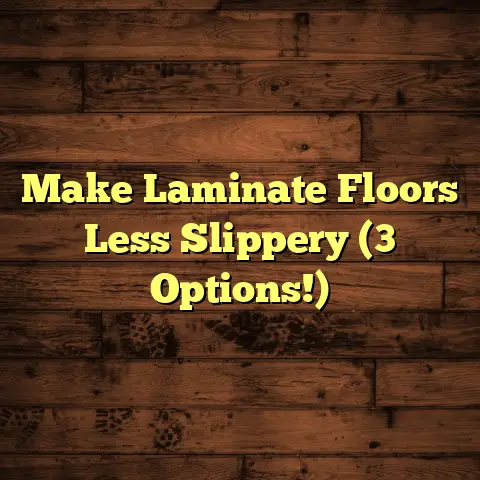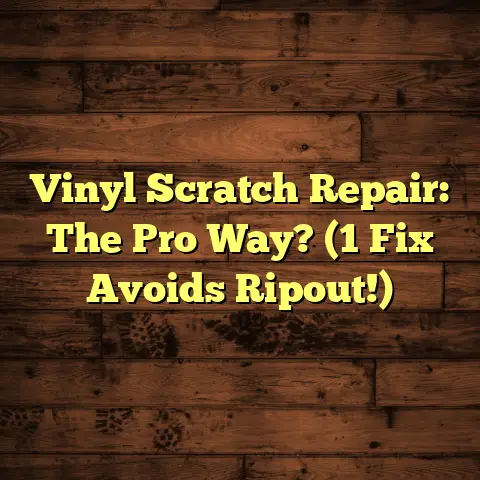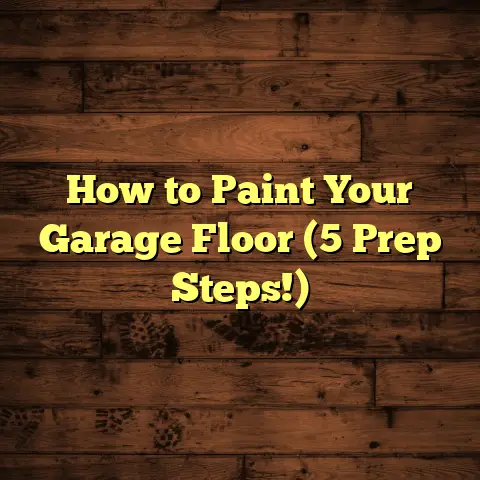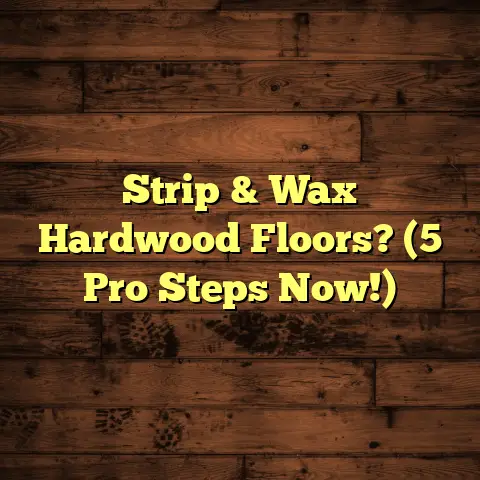How To Seal Floor Gaps? (3 Fixes Needed Now!)
Have you ever walked into a room and felt like something was just…off?
Maybe the furniture was perfect, the paint was fresh, but there was still a nagging feeling that the space wasn’t quite right?
Chances are, you might have been subconsciously noticing those pesky floor gaps!
As a flooring contractor with years of experience, I can tell you that those little gaps can be a major eyesore.
They disrupt the visual flow of a room, making even the most beautifully designed spaces look a bit unkempt.
Imagine a stunning living room with hardwood floors, a cozy fireplace, and elegant furniture.
Now picture those floors riddled with dark, unattractive gaps.
Suddenly, the whole room loses its charm, right?
But don’t worry! Sealing those gaps isn’t just about aesthetics.
It’s also about protecting your investment and improving the overall comfort of your home.
In this article, I’m going to walk you through everything you need to know about sealing floor gaps, from understanding why they happen to three effective fixes you can tackle right now!
Section 1: Understanding Floor Gaps
So, what exactly are floor gaps, and why do they appear in the first place?
Well, floor gaps are those annoying spaces that develop between individual floorboards or tiles.
They’re a common problem, and they can be caused by a variety of factors.
One of the biggest culprits is shrinkage, especially in wood flooring.
Wood is a natural material that expands and contracts with changes in humidity.
When the air gets dry, wood loses moisture and shrinks, creating gaps.
According to the Forest Products Laboratory, wood can shrink by as much as 5-10% across its width as it dries from green to oven-dry condition.
This shrinkage is more pronounced in wider boards, which is why you might notice larger gaps in floors with wider planks.
Another common cause of floor gaps is poor installation.
If the flooring wasn’t installed properly to begin with, gaps can appear over time as the boards shift and settle.
I’ve seen cases where installers didn’t leave enough room for expansion, and the floors buckled and gapped as a result.
Different types of flooring are prone to gapping for different reasons.
- Hardwood: As mentioned, hardwood is susceptible to shrinkage due to humidity changes.
- Laminate: Laminate can gap if it’s not installed properly or if it’s exposed to excessive moisture.
- Tile: Tile gaps are usually due to grout cracking or crumbling, which can happen over time due to wear and tear or improper installation.
Beyond the aesthetic issues, floor gaps can also impact the overall atmosphere of your space.
They can become traps for dust, dirt, and debris, making it harder to keep your floors clean.
I’ve even seen cases where floor gaps became breeding grounds for pests like ants and spiders!
Think about it: those gaps provide the perfect hiding place for creepy crawlies.
Section 2: The Importance of Sealing Floor Gaps
Okay, so we know that floor gaps are unsightly and can create some hygiene issues.
But why is it so important to seal them?
Well, sealing floor gaps offers a whole host of benefits, both aesthetic and practical.
First and foremost, sealing gaps instantly improves the appearance of your floors and your entire room.
It creates a smooth, seamless look that elevates the overall design.
I’ve seen rooms transformed from drab to fab simply by sealing those distracting gaps!
But the benefits don’t stop there.
Sealing floor gaps can also improve your home’s energy efficiency.
Those gaps can let in drafts, making your heating and cooling systems work harder to maintain a comfortable temperature.
According to the U.S. Department of Energy, air leaks can account for as much as 30% of a home’s heating and cooling costs.
Sealing those gaps is like adding an extra layer of insulation to your floors!
Another crucial benefit of sealing floor gaps is preventing moisture intrusion.
Water can seep into those gaps and damage the subfloor, leading to costly repairs down the road.
Moisture can also promote mold growth, which can be a serious health hazard.
Sealing gaps creates a barrier that protects your floors and subfloor from moisture damage.
Finally, sealing floor gaps can reduce noise levels in your home.
Gaps can amplify sounds, making footsteps and other noises seem louder.
Filling those gaps can help dampen sound vibrations, creating a quieter and more peaceful environment.
I remember working on a project in an old Victorian house where the floors were incredibly creaky.
After sealing the gaps and reinforcing the subfloor, the difference in noise levels was remarkable!
The homeowners were thrilled with the results.
Section 3: Fix #1 – Using Caulk
Alright, let’s get down to the nitty-gritty and talk about how to actually seal those floor gaps.
Our first fix is using caulk, which is a versatile and effective option for sealing gaps, especially around the perimeter of the room or in areas where the floor meets the wall.
Caulk is a flexible material that can expand and contract with the floor, making it ideal for areas that experience movement.
But not all caulk is created equal.
Choosing the right caulk is crucial for a successful and long-lasting repair.
Here’s what you need to consider:
- Color-matching: Choose a caulk that closely matches the color of your flooring. This will help the repair blend seamlessly with the surrounding area.
- Flexibility: Opt for a caulk that is designed for use on floors and that has good flexibility. This will prevent it from cracking or peeling over time.
- Durability: Look for a caulk that is waterproof and resistant to mildew. This is especially important in areas that are exposed to moisture, like bathrooms and kitchens.
Some popular caulk options for floors include:
- Acrylic caulk: This is a good general-purpose caulk that is easy to apply and clean up.
- Silicone caulk: Silicone caulk is more flexible and durable than acrylic caulk, making it a good choice for areas that experience a lot of movement or moisture.
- Latex caulk: Latex caulk is paintable, which can be useful if you want to customize the color of the caulk to match your flooring.
Once you’ve chosen the right caulk, you’ll need a few tools:
- Caulk gun: This is used to dispense the caulk from the tube.
- Utility knife: This is used to cut the tip of the caulk tube at a 45-degree angle.
- Caulk smoother: This is used to smooth out the caulk and create a professional-looking finish.
- Damp cloth: This is used to clean up any excess caulk.
Now, let’s get to the application process:
- Preparation: Start by cleaning the gaps thoroughly. Remove any dirt, dust, or debris with a vacuum cleaner or a damp cloth. Make sure the gaps are dry before applying the caulk.
- Cutting the caulk tube: Use a utility knife to cut the tip of the caulk tube at a 45-degree angle. The size of the opening will determine the amount of caulk that is dispensed.
- Loading the caulk gun: Insert the caulk tube into the caulk gun.
- Applying the caulk: Hold the caulk gun at a 45-degree angle and apply a steady bead of caulk along the gap. Try to apply the caulk in a smooth, even line.
- Smoothing the caulk: Use a caulk smoother or your finger to smooth out the caulk and create a seamless finish. Wipe away any excess caulk with a damp cloth.
- Drying time: Allow the caulk to dry completely before walking on the floor. Drying time will vary depending on the type of caulk you use.
Here are a few tips for achieving a smooth finish:
- Use a wet finger: Dip your finger in water before smoothing the caulk. This will prevent the caulk from sticking to your finger.
- Work in small sections: Apply the caulk in small sections and smooth it out before moving on to the next section.
- Practice: If you’re new to caulking, practice on a scrap piece of material before applying the caulk to your floors.
Section 4: Fix #2 – Wood Filler
Our second fix is using wood filler, which is an excellent option for sealing gaps in hardwood floors.
Wood filler is a paste-like substance that is designed to fill gaps and imperfections in wood.
It comes in a variety of colors and can be stained or painted to match your flooring.
Choosing the right wood filler is essential for a seamless repair.
Here’s what you need to consider:
- Type of wood: Choose a wood filler that is compatible with the type of wood your floors are made of. Some wood fillers are designed for use on specific types of wood, like oak or maple.
- Color: Select a wood filler that closely matches the color of your flooring. You can also mix different colors of wood filler to create a custom match.
- Stainability: If you plan to stain your floors after filling the gaps, choose a wood filler that is stainable.
Some popular wood filler options include:
- Water-based wood filler: This is a good general-purpose wood filler that is easy to apply and clean up.
- Solvent-based wood filler: Solvent-based wood filler is more durable and water-resistant than water-based wood filler.
- Epoxy wood filler: Epoxy wood filler is the most durable type of wood filler and is ideal for filling large gaps or repairing damaged wood.
Here are the tools you’ll need for this project:
- Putty knife: This is used to apply the wood filler to the gaps.
- Sanding block: This is used to sand down the wood filler after it has dried.
- Fine-grit sandpaper: This is used to smooth out the wood filler and blend it with the surrounding wood.
- Vacuum cleaner: This is used to clean up any dust or debris.
Here’s the application process:
- Preparation: Start by cleaning the gaps thoroughly. Remove any dirt, dust, or debris with a vacuum cleaner or a damp cloth. Make sure the gaps are dry before applying the wood filler.
- Applying the wood filler: Use a putty knife to apply the wood filler to the gaps. Overfill the gaps slightly, as the wood filler will shrink as it dries.
- Drying time: Allow the wood filler to dry completely. Drying time will vary depending on the type of wood filler you use.
- Sanding: Once the wood filler is dry, sand it down with a sanding block and fine-grit sandpaper. Start with a coarser grit sandpaper and gradually move to a finer grit. Sand the wood filler until it is flush with the surrounding wood.
- Finishing: After sanding, you can stain or paint the wood filler to match your flooring.
Here are a few tips for color matching:
- Test the wood filler: Before applying the wood filler to your floors, test it on a scrap piece of wood to make sure it matches the color of your flooring.
- Mix colors: If you can’t find a wood filler that perfectly matches your flooring, try mixing different colors of wood filler to create a custom match.
- Use a stain: If you plan to stain your floors after filling the gaps, use a stain that matches the color of your flooring.
Section 5: Fix #3 – Floorboard Replacement
Sometimes, sealing gaps with caulk or wood filler just isn’t enough.
In cases where the gaps are too large, or the floorboards are damaged or poorly fitting, replacement is the best option.
Replacing floorboards can seem daunting, but with the right tools and a little patience, it’s a project you can tackle yourself.
First, you need to identify the boards that need replacement.
Look for boards that are:
- Severely damaged: Cracked, splintered, or rotted boards should be replaced.
- Poorly fitting: Boards that are warped or uneven can create large gaps and should be replaced.
- Mismatched: If you have boards that are a different color or grain than the rest of your flooring, replacing them can improve the overall aesthetic.
Once you’ve identified the boards that need replacement, you’ll need to gather your tools:
- Pry bar: This is used to remove the old boards.
- Hammer: This is used to tap the new boards into place.
- Chisel: This is used to clean up any rough edges.
- Measuring tape: This is used to measure the new boards.
- Saw: This is used to cut the new boards to size.
- Nail gun or hammer and nails: This is used to secure the new boards to the subfloor.
Here’s the step-by-step guide to replacing floorboards:
- Remove the old board: Use a pry bar to carefully remove the old board. Be careful not to damage the surrounding boards.
- Prepare the subfloor: Clean up any debris or old nails from the subfloor. Make sure the subfloor is level and in good condition.
- Measure and cut the new board: Measure the space where the old board was and cut the new board to size.
- Install the new board: Place the new board in the space and tap it into place with a hammer. Use a nail gun or hammer and nails to secure the new board to the subfloor.
- Finishing: Sand down any rough edges and finish the new board to match the surrounding flooring.
Here are some tips for matching new boards with existing ones:
- Buy from the same source: If possible, buy the new boards from the same source as the existing flooring. This will increase the chances of getting a good color and grain match.
- Blend the boards: When installing the new boards, try to blend them in with the surrounding boards. This can be done by alternating the direction of the grain or by using a stain to match the color.
- Consider the age of the flooring: Keep in mind that the existing flooring may have faded or changed color over time. When choosing new boards, try to find ones that are a similar color to the aged flooring.
Conclusion
So, there you have it! Three effective fixes for sealing those unsightly floor gaps.
Whether you choose to use caulk, wood filler, or replace the boards altogether, addressing those gaps is an investment in the beauty and longevity of your floors.
Remember, those little gaps can have a big impact on the overall look and feel of your home.
By taking the time to seal them, you can transform your space, improve its energy efficiency, and protect your investment.
Don’t let those gaps detract from the beauty of your home any longer.
Take action today and choose the fix that best suits your needs.
Your floors will thank you for it!





